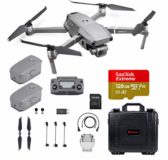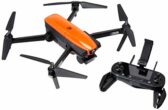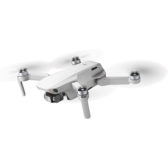The Best Foldable Drones of 2021: Perfectly Portable Quadcopters
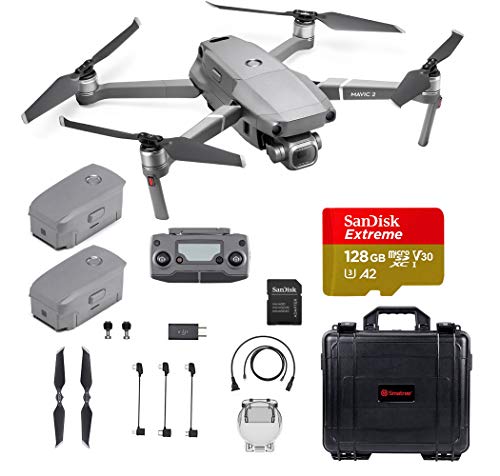
DJI Mavic 2 Pro
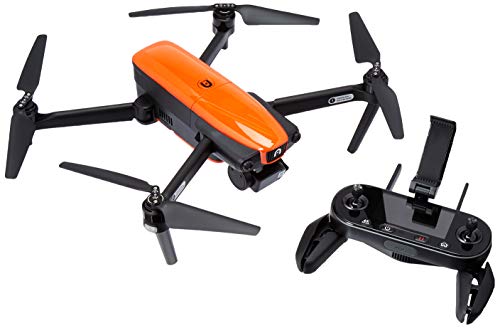
Autel Robotics EVO
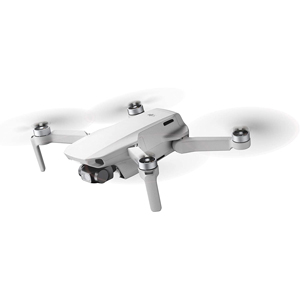
DJI Mini 2
Foldable drones have taken the quadcopter scene by storm. What started as a fad quickly turned into an essential feature in modern drones.
In hindsight, this isn’t too much of a surprise. The ability to fold up has made these previously oversized cameras genuinely portable. This, in turn, has allowed more people to get into the hobby.
Today, many UAVs in the market have this style of design. Not the majority, but a reasonable number. While this is a good thing, it can also be pretty overwhelming for the casual buyer.
So we’re here to help!
Let us demystify the whole process for you and guide you on the path to finding the best folding drone you can buy today.
The Best Foldable Drones 2021
We may receive compensation on qualifying purchases via our links. This does not change how we review items. For more information, please read our affiliate disclosure.
The DJI Mavic is one of the most amazing foldable drones in the market, bar none. They have further solidified this reputation with the Mavic 2.

- Flight Time: 30 minutes
- Range: 7 kilometers
- Camera: 4K resolution at 30 fps; 20 MP stills
- Weight: 1.64 pounds
- Gimbal: 3 Axis
DJI is the company that popularized the foldable drone with their Mavic line. And this influence can clearly be seen with the number of copycats and “me too” drones that all borrow from the aesthetics of the Mavic.
The Pro version has a powerful Hasselblad L1D-20c 20MP / 4K UHD camera coupled with a 1 inch CMOS sensor. Pound for pound, this is the best camera ever put on a drone. If you’re a pro photographer or videographer, this is the one to get. The photo quality is absolutely stunning.
Either way, you go, you’re looking at a high-performing foldable drone with specs that are the best in any consumer model out there.
The flight time is at a whopping 30 minutes, which is the longest you’ll ever achieve in a consumer drone. And that’s considering that it uses its full camera capabilities. Even when it falls short and just delivers 25 minutes, it’s still quite impressive.
The range is also something to write home about. It has a range of 8 km, a fantastic feat, really. The FPV range also reaches this distance, making the Mavic 2 the drone of choice for long-distance surveillance and recon tasks.
Mavic 2 also has advanced features like an omnidirectional obstacle avoidance system, which gives it protection from all directions. Then you have the autonomous flight modes powered by their remarkable visual recognition system, Active Track.
Of course, you get the DJI basics of flight stability, durability, and intuitive controls.
Overall, the Mavic 2 series is one fantastic piece of foldable drone tech.
+ Pros
The EVO is one of the few drones out there that we honestly think stands a chance against the current dominance of DJI.

- Flight Time: ~30 minutes
- Charge Time: ~210 minutes
- Range: 7050m / 4.4 miles
- Remote Controller: WiFi 2.4GHz (included in the set)
- Camera: 3-axis gimbal 4K 60fps camera with 12MP
- Live Video Transmission Range: 7000m / 4.3 miles
- Weight: 863g / 1.9lbs
- Carry Capacity: N/A
- Working Temperature: 0°C ~ 40°C
- Rated for outdoor use
Autel Robotics really did a great job of coming up with a somewhat original and advanced drone of their own as an answer to the Mavic.
The EVO itself is an advanced foldable drone that’s surprisingly resilient. While I’m sure the Mavic is sturdy, the EVO gives the impression of being sturdier and more rugged. It has limited resistance to water (we got caught in a light drizzle with no problems)
The specs of the EVO are, in a word, impressive. It has a flight time of around 30 minutes and a range of 7 km. Both of these are some of the best specs in the industry.
Personally, we’ve experienced an average of around 25 minutes of flight time with this drone, depending on which features we use. We haven’t tried out testing the extremely long range of this. Still, we find the FPV and responsiveness of the EVO to be top-notch at shorter distances (farthest we tested it was at 2 km).
Adding to the versatility of the EVO is its suite of intelligent flight modes. These are some of the best and advanced we ever used in any of the drones we tested, save for DJI. The visual recognition system works accurately enough that it was able to track us well.
Rounding out the EVO is the safety features of the drone. The highlight of this is the obstacle avoidance system, which works to protect it from the front and rear. You also have the Go Home feature and Starpoint Positioning, which allow it to maintain position even without GPS.
The camera is standard for drones at this tier. 4K video resolution, 3-axis gimbal, and Ambarella H2 processors produce professional-grade and smooth footage.
All in all, Autel pulled out all the stops for the EVO. It’s a fantastic drone for just about anyone, but really shines when used as a long-range inspection and recon drone.
+ Pros
- Cons
Our top rated mini drone with huge performance in a tiny body. Perfect for…everyone!

- This drone weighs less than 250g
- 12MP camera / 4K video, 4x digital zoom
- 3-axis motorized gimbal for image stability
- 10km range, max altitude of 4km
- Battery life: 31 minutes
DJI just can’t seem to stop releasing incredible drones.
The original Mavic Mini was our best ever value-for-money pick and now DJI have outdone themselves with the Mini 2.
We are blown away with the quality, performance and battery life that you can get with the DJI Mini 2 for a fairly affordable price. No, it’s not cheap, but its price falls far below most top products from competitors.
We’d say it’s now our favorite value-for-money pick by a long way, and it’s perfect for photography, videography, traveling, hobbyists and, well, everyone else too!
Better still, with its weight under 249g, it doesn’t even need to be registered with the FAA or CAA. That means you don’t need to be a registered drone pilot to fly this beauty.
+ Pros
- Cons
For the casual user who just wants to have a reliable foldable drone to take with them anywhere, the DJI Mavic Mini is the one for you.
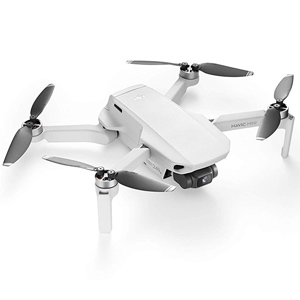
- Flight Time: ~28 minutes
- Charge Time: ~90 minutes
- Range: 3000m / 9842ft
- Remote Controller: WiFi 5.4GHz & 2.4Ghz (included in the set)
- Camera: 3-axis gimbal 2K Camera with 12MP
- Live Video Transmission Range: 2500m / 8200ft
- Weight: 249g / 8.78oz
- Working Temperature: 0°C ~ 40°C
- Rated for indoor and outdoor use
It’s one of the smallest drones in DJI’s lineup, fitting in the palm of your hand, weighing no heavier than a smartphone. And that’s one of its most significant advantages.
Clocking in at just 249g, it doesn’t need registering with the FAA or the CAA.
The Mavic Mini is clearly made for regular, everyday use. Thankfully, despite this, this drone inherited some useful features from its bigger brothers.
At the heart of the Mini is its compact but powerful camera, which can take photos at 12-megapixel resolutions and video at 2.7K. Rare for a mini drone at its price tier, it’s also equipped with a 3-axis gimbal, so footage you capture is smooth and jitter-free.
The flying experience is simple and in a good way. The DJI fly app makes it easy for anyone, even a complete beginner, to operate the Mini. It has tons of auto flight modes, preset flight paths, and “tap flight” for easier handling.
The performance of the Mini is remarkable as well, and we were surprised to find out that it has a flight time of 30 minutes. In its price class, that’s off the charts, really. Flight stability is also DJI-level.
With that being said, the controls and features might be a little too simplistic for a veteran drone pilot. Everything is geared more towards creative photography and social features. But for newbies and the casual tourist/teen, that’s one of the reasons why it’s the best drone to get.
Overall, the Mavic Mini gets what makes DJI great and compresses it into a tiny, beginner-friendly foldable drone.
+ Pros
- Cons
The Parrot Anafi is a good pick for you if you’re looking for a premium foldable drone but at a mid-tier price point.
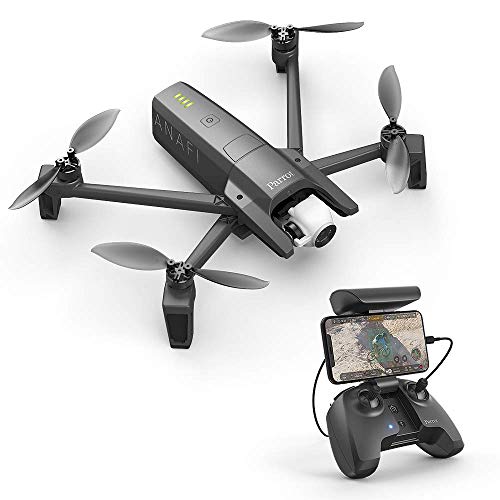
- Flight Time: ~25 minutes
- Charge Time: ~240 minutes
- Range: 4000m / 2.5mi
- Remote Controller: WiFi 5.4GHz & 2.4Ghz (included in the set)
- Camera: 180° adjustable f/2.4 ASPH lens 4K Camera with 21MP
- Live Video Transmission Range: 4000m / 2.5mi
- Weight: 320g / 11.28oz
- Working Temperature: -10°C to 40°C
- Rated for indoor and outdoor use
One of the best features of the Anafi is its portability. The unit weighs in at just 320g, so it won’t really drag you down. It also folds down into a neat, horizontal shape that we find much more manageable to store (at least for us).
The smaller and lighter frame of the Anafi gives it outstanding maneuverability. We overall liked how easy it was to control and pretty responsive, too. The included Skycontroller 3 remote controller made it much easier for us to fly this thing.
Surprisingly, we find the Anafi to be stable to fly despite it feeling light. It has excellent wind resistance, so it’s pretty forgiving on when and where you operate it. It’s also one of the quietest drones we’ve used.
Performance-wise, you’re looking at 25 minutes of flight time with a 4 km range. That’s impressive if you ask me. The installed intelligent LiPO battery also charges 60% faster, so you’ll be back up quicker than ever.
The photo quality of the Anafi isn’t too bad, either. You’re looking at a 4K video resolution with 21 megapixels for photos. All of this is powered with a 1 / 2.4 inch CMOS sensor. A 3-axis gimbal ensures very stable and smooth shots. Overall amazing camera.
Safety features include a Smart RTH (Return to Home) feature that instructs it to safely return to its takeoff point when low on power, avoiding a crash. If the inevitable happens, though, the Find My Drone feature acts as an insurance policy so you can still easily find your Anafi.
In our mind, the Parrot Anafi is one of our favorite compact foldable drones out there. We like how it packs in so much power and features and manages to be so portable. This makes it the perfect travel drone for both pros and casual users alike.
+ Pros
- Cons
Full to the brim with features you’ll typically find in DJI or Autel, the Hubsan Zino Pro is your pro-level drone at a fraction of the cost – less than $500, to be exact!
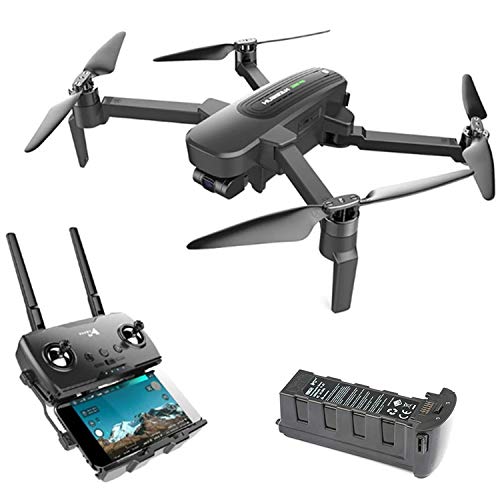
- Flight Time: 26 minutes
- Range: 4 km
- Camera: 4K UHD camera with 3-axis gimbal
- Weight: 710g
Performance-wise, the Zino Pro is capable of flying for up to 23 minutes on a single charge. Our own test flights, however, place it at around 19 – 20 minutes. For the price, this is still pretty darn impressive.
The range is remarkable as well, at around 4 km. This puts it at the high upper end in terms of transmission distance. We tested the FPV mode at these distances, and, thankfully, the video feed held up. The smooth experience overall that helped us fly this drone in FPV better.
The Zino Pro is also a decent and stable flyer, able to maintain and hold its position even in Class 5 winds.
As for the camera, the Zino Pro delivers true 4K UHD resolution, with an installed 3-axis gimbal. This produces top-notch photo and video footage, making it excellent for photographers and videographers.
A cool thing about the Zino Pro’s camera is the removable lens. You can apply filters, swap out lenses, or otherwise get really creative with your shots. The lens is adjustable and can be rotated from 90 – 360 degrees.
For a sub $500 drone, the Zino Pro has plenty of autonomous flight features. Mainstays include Line Fly Mode and Orbit Mode, allowing it to fly in a straight line or around an object of focus, respectively. This is fantastic for site inspections, allowing you to focus on observation and leave the piloting to the drone.
For more creative videography shots, you also have Waypoints Mode. With it, you can set up pre-determined points the Zino Pro must follow. The cool thing is that this path is repeatable, allowing you to have as many takes as you need.
Overall, the Hubsan Zino Pro is an impressive drone at a reasonable price. It’s great for professionals who need quality and features but have a more limited budget.
+ Pros
- Cons
The Potensic D88 is an easy to carry foldable drone. While not as small as some other drones in this list (it’s about the size of a small tablet), it’s still manageable.
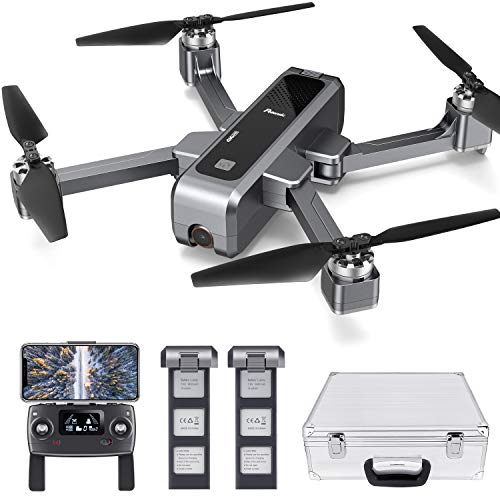
- Follow Me Method: GPS
- Flight Time: 20 minutes
- Camera: 2K resolution camera
- Weight: 5.25 pounds
The way it folds down makes it easy to hold on one hand. As a bonus, it has its own aluminum case, so it’s well protected when you decide to pack it in your suitcase.
At its core, the D88 is a capable flyer. It’s equipped with four 1,350 kV motors, giving it exceptional stability on air and max speeds of up to 50 km/h. While you probably won’t be racing with this one, it still makes for nimble flight and quick positioning for that perfect shot.
It also has stability features onboard, from ultrasonic sensors to optical flow cameras. This enables it to hover in place autonomously.
Powering the D88 is a high capacity 3,400 mAh battery, providing up to 20 minutes of flight time, or around 16 minutes if used with major features turned on.
The equipped camera is where it falls a little short for most pro users, clocking in at only 2K resolution. For the casual drone owner, however, this is more than enough.
The 5G WiFi transmission also gives it a control range of 1.5 km and an FPV range of 300m. Yes, the FPV range might be too short for more professional uses.
The D88 does have its own autonomous flight modes that make up for this deficiency. The D88 has the Return to Home safety feature and Follow Me mode, thanks to its onboard GPS. Both work pretty accurately, from our own experience with it.
Other noteworthy features include Waypoint Mode and Points of Interest. Both enable the D88 to fly on its own by following a predetermined path you have set.
All in all, the D88 didn’t disappoint. It’s an affordable foldable drone with powerful flight performance and auto features. Perfect for more casual users
+ Pros
- Cons
A variant of the Mavic 2, the Zoom can (perhaps unsurprisingly) zoom really well — up to 4x in lossless full HD.
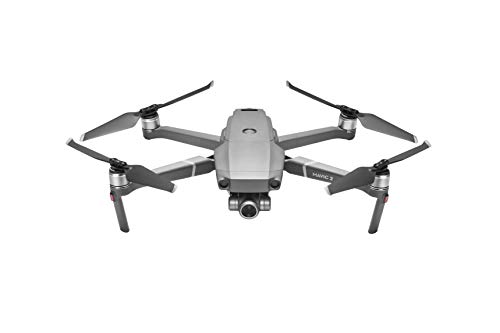
- Flight Time: 31 minutes
- Range: 8 kilometers
- Camera: 4K resolution at 30 fps; 48-MP super resolution stills
- Take-off Weight: 905g
- Gimbal: 3-Axis
The Zoom version of the Mavic 2 technically has an inferior camera, but it does have on feature the Pro doesn’t: up to 4x optical zoom.
This is the recommended version if you’re using the Mavic 2 for FPV purposes, like site inspections or for hunting purposes.
It also shows that specs on paper doesn’t always dictate the quality of a product, because the Zoom’s zooming feature is spectacular.
+ Pros
The Ruko F11 Pro is for you if you’re keen on getting the flight performance and features of a big name foldable drone, but find that you’re a little short on budget.
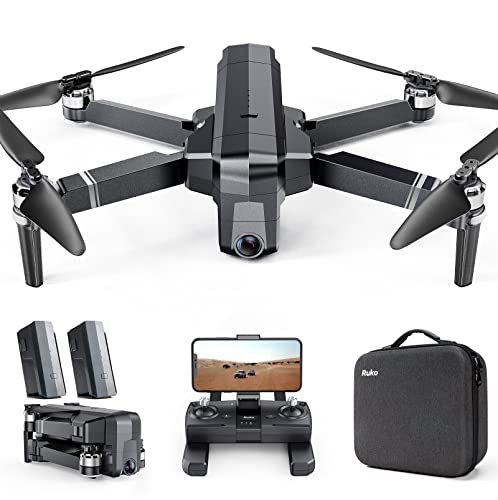
- Flight Time: ~28 minutes
- Charge Time: ~210 minutes
- Range: 1219m / 4000ft
- Remote Controller: WiFi 5GHz (included in the set)
- Camera: 90°Adjustable 4K Camera with 13MP
- Live Video Transmission Range: 500m / 1640.4ft
- Weight: 520 g / 18.34 oz
- Rated for indoor and outdoor use
The relatively affordable price is one of the main highlights of this cool-looking drone.
In terms of size, this drone is definitely compact. When folded, it reduces to the same size as that of a smartphone. It also has roughly the same weight, making it a joy to bring around.
For one, the F11 Pro has a flight time of 30 minutes. It’s undoubtedly on par with the best drones out there. A bonus with the F11 is that it includes a spare battery by default, giving you a grand total of 60 minutes of flight time right out of the box. Definitely appreciated!
The F11 Pro’s range is at a decent 1.2 km, but its FPV video feed is only up to around 500 meters. At most, you can’t use it for long-range surveillance.
The camera quality of the F11 Pro isn’t too bad as well, capable of achieving 4K photo resolution (2.9K for video). While it certainly can’t compete with the resolution of the high-end drones, it definitely produces better images than other drones in its price class.
The intelligent flight modes of the F11 Pro is commendable as well. The most useful for us is TapFly, allowing you to create a path for the drone to follow by tapping points in the app’s map.
Overall, the Ruko F11 Pro is an excellent alternative to the more costlier models from high-end brands. This is perfect for backpackers or hikers for its portability and price. It’s also our favorite drone for roof inspections, as it is cheap and has decent FPV capabilities.
+ Pros
- Cons
No products found.
The Snaptain A15 can probably lay claim to being one of the most affordable foldable drones out there. It’s also one of the most compact, compressing down to a size that can be easily held in one hand.
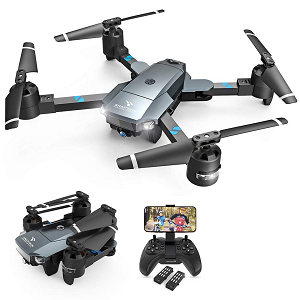
- Flight Time: 15 minutes
- Camera: 720p HD camera with 120-degree FOV
- Weight: 680g
- Flight Features: Headless Mode, One Key Takeoff/Landing, 3D Flips, Altitude Hold, Gravity Sensor, 3 Speed Modes
The beautiful thing about the A15 is that it’s packed with features that belie its crazy sub-$100 price tag.
For one, you’re looking at 15 minutes of flight time with the A15. There’s a 5-8 minute average battery life in this price range, so this is exceptionally long. It’s also capable of stable flight, and the drone is very responsive and maneuverable.
One of the highlights of the A15 is its suite of smart flight features. The basic is Altitude Hold, which allows it to maintain its vertical and horizontal position on its own effortlessly. It’s also equipped with One-Touch Takeoff/Landing, which means anybody can quickly launch the A15.
For more advanced modes, you can give Trajectory Flight a try. It works the same way as Waypoint Mode does in other models. You can draw a predetermined path in the app, and the A15 will faithfully follow it.
Because of this, the A15 is very beginner-friendly. Combined with Headless Mode, anyone with zero drone experience will not have a problem operating it. Voice control is meant to aid in this, but personally, it’s not a very accurate way to control your drone in practice. It’s fun, though!
The rest of the features include 3-speed adjustments, should you feel the need to let the A15 really fly. The 360 flips are great for some fun kicks but are generally useless, in our opinion. Gravity Sensor mode allows you to control the drone by tilting your smartphone. Not very fond of it, but you might.
All in all, the Snaptain A15 is the best entry-level foldable drone in terms of both skill level and price. We generally love it for its exceptional flight modes and beginner-friendly features.
+ Pros
- Cons
No products found.
The Mavic Air 2 is a groundbreaking development in the mid-budget range. Almost no other drone compares for the price.
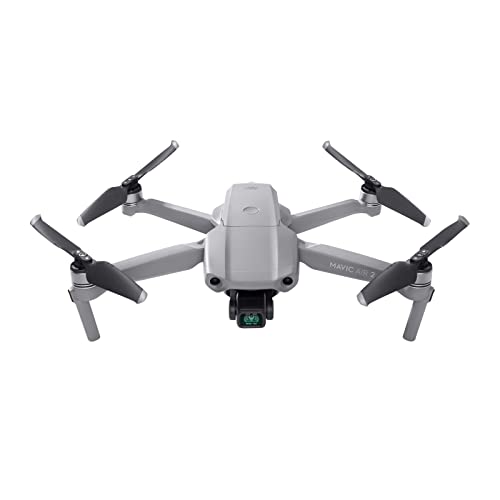
- Flight Time: 34 minutes
- Weight: 1.3lbs / 0.59kg
- Camera: 48MP with 4K/60FPS video
- Range: 10km / 6.2 miles
The DJI Mavic Air 2‘s quality isn’t much of a surprise to anyone that knows the drone space — we’ve been blown away with what this machine is capable of considering it falls way below the $1,000 price tag that is usually required for such a premium product.
Its 34 minutes of flight time is staggering given its size and price, making it one of the biggest battery life drones you’ll find.
The Mavic Air 2 has obstacle detection in three different directions and intelligent tracking, along with DJI’s ActiveTrack technology, to also make this one of the best bang-for-the-buck follow me drones that there are.
With a 48MP 1/2-inch CMOS sensor camera and 4K video supported by a 3-axis gimbal, this is a brilliant option for anyone looking to take premium quality photos and videos without having to spend an arm and a leg.
+ Pros
- Cons
What is a Foldable Drone?
A foldable drone makes it possible to compress it down to a size that makes carrying it around infinitely easier. This is done by “folding” the legs and propellers of the drone into its body. The result is a very streamlined shape with no parts left dangling out.
The folding in and out process is typically straightforward and takes just seconds to setup.
Foldable drones were popularized by DJI with their Mavic series. Before that, drones were very bulky, making transporting them quite a challenge. They were also very prone to being damaged while in transit because there were so many extended parts.
In the beginning, drones that folded up were very underpowered and cheap and were mostly a novelty. But nowadays, technology has improved to the point that some of the most powerful drones in the market are often foldable. An example of this is the Mavic 2, one of the most advanced consumer drones ever put in the market.
What to Look For In A Foldable Drone
Foldable drones isn’t technically a single category of drones but is a standard feature in a large majority of them. This means that the specifications and features would vary greatly.
You, therefore, have to consider quite a lot of things when it comes to picking the right one for your needs.
Size and Weight
We’re going to assume that you’re looking for something portable.
However, the fact that it can be folded up is just one part of the portability equation. You also need to consider two more things: the actual size and weight. After all, it won’t be easy to transport it if it’s heavy, no matter how small it is.
Weight is subjective, but we generally recommend anything around 500 grams to be reasonable. There’s also a nice bonus if you get a lighter drone: you might need to register it with the local authorities. In the US, for example, only drones 250g and above need to be registered with the FAA.
Lighter drones also tend to consume less power and therefore have longer flight times. This can also be seen as contributing to its portability.
The material used in the drone has the most influence on how heavy it is. Cheaper drones are made of plastic, which is a lightweight material but is not very durable. Carbon fibers are the preferred choice, as they offer a good combination of lightness, durability, and cost (though they, of course, cost more than plastic).
In the end, how heavy and big your drone is will come down to personal preference. If you’re only taking casual photos and value portability much more, then go for the smallest and lightest drone you can find.
However, if the photo quality is the one you’re after, then find one with the best camera. You might need to sacrifice a bit of portability to get this, however.
Durability
Durability is an important consideration because you’re more likely to take your drone to more locations when it’s easier to transport. Personally, I try to find something that’s both durable and portable, and you should, too.
They really need to be rugged and durable, whether they’re flying in the field or stowed away in your luggage. You never know what kind of flight conditions you’ll encounter, and we all know of the horror stories of people mishandling baggage at airports.
You can take precautions like getting a hard carrying case for your drone, but all of it starts from durability.
It’s also essential to have a sturdy drone when you’re deploying it in the field. Especially if you’re in a crowded tourist spot, for example, you never know what obstacles you’ll encounter.
The drone’s frame pretty much dictates the sturdiness of your flyer. As mentioned in the previous section, carbon fiber is great to have because of its durability. It should provide ample protection for the delicate electrical components inside your drone.
Related with durability, you can also try looking for a weatherproof drone. This means it’s at least waterproof and windproof. While not many drones have this in the market, having one will give you peace of mind, especially when you’re flying outdoors in unpredictable weather.
Flight Time
One of the most critical considerations that top any drone owner’s list is battery life. The more of it you have, the longer you can fly your drone. And that means more fun!
For foldable drones, this is even more crucial. Since they’re usually used when out traveling, you need to be able to use them for as long as possible. This is especially so with hikers and backpackers who might go to an area without any electricity.
A drone’s price tier is a good rule of thumb to judge its flight time (although there are exceptions). The most expensive drones usually have flight times of around 25 – 30 minutes. Those in the mid-price range (around $500+) will have flight times of approximately 15 – 20 minutes. These offer the best bang for your buck, providing a good balance of price vs. battery life.
If you find your drone is lacking in battery capacity, a good solution is to invest in a few spare batteries. You might need to spend around 1 – 2 minutes landing and swapping it, but it still beats having to recharge it for an hour or so.
Smart Flight Features
Smart flight modes allow your drone to fly itself autonomously, either by a predetermined path or by tracking you. If you mostly travel alone, this is an essential feature to have.
And even if you’re not traveling alone, this is still a useful mode to have. Professional videographers, in particular, can use them to execute complex moving shots repeatedly and accurately.
One of the most common smart flight features is Follow Me mode. With this, your drone will fly around and follow you around, either by visually tracking you or via the use of GPS tethering.
Smartphone Control
In my guides, I usually recommend having access to a physical analog controller when piloting your drones. The reason is that you’ll develop crucial flight skills that will serve you well later, which you won’t learn by doing it on a smartphone.
With that said, being able to use your smartphone as a transmitter is very handy. This way, you don’t need to pack an extra controller just to fly your drone, which can take up space. Controllers are also yet another thing to charge.
Don’t worry, though, as most drone smartphone apps today are competent and intuitive. Plus, they give you a host of features that’s hard to come by with controllers, such as FPV (First Person View) mode. You also usually access intelligent flight modes via the app.
Camera Quality
For most casual users, a mid-range camera will more than suffice. These are cameras in the 1080p to 2K range, with 5 – 12 megapixels of photo resolution. You can even sometimes get low-end 4K cameras at this tier.
Pros and vloggers, of course, shouldn’t get anything below 4K resolution. If you plan to do a lot of heavy editing later on, then you should also get cameras capable of shooting in the RAW format.
For industry uses like site inspections, you need to take a look at its camera resolution in FPV mode. This is usually either in 720p or 1080p HD.
Range
A drone’s range is simply the distance at which you’re able to control it using your controller. In effect, it also says how far out your drone can fly. When most people buy a drone, the range isn’t usually an essential factor. But the truth is, it’s a lot more crucial thing than you think in certain conditions.
Having a long range means your drone has a more robust transmission. Therefore, at shorter ranges, it would be less prone to disruptions and lags, making flying your drone much more responsive.
Certain users also benefit from having a long range. Site inspections and professional wildlife photography are some of the instances where you’ll need to fly your drone farther out.
For most purposes, however, a range of 1 km is ideal.
FPV (First Person View) Mode
In essence, this allows you to see what your drone sees. This will enable you to fly your drone out even when you can’t see the actual device itself.
This is a crucial feature to have when using your drone for hunting and roof inspections. These require you to have eyes on your drone even when it breaks your line of sight, something that FPV can give.
An essential thing for FPV is that it’s as lag-free as possible. A laggy feed will slow down your reaction time, making you prone to crashes.
This means the transmission power and range of your drone is top-notch. Take note that the video quality of FPV is usually lower than that of the actual resolution of your video camera.
If you’re looking into using FPV mode, we recommend a range of more than 1 km, and 1080p HD resolution if possible (although 720p is usually OK as well).
Safety Features
Given how expensive and nimble foldable drones are, they’re prone to being damaged or becoming lost. That’s why most of them are equipped with safety features to help protect your investment from disaster.
One of the most basic of these features is Auto Return to Home. This feature enables your drone to automatically return to its takeoff point when certain conditions are met. This is almost always when it either runs out of battery or if it loses signal connection. With this feature, catastrophic crashes are avoided.
Some drones would also have obstacle avoidance installed, although these are limited to the more expensive ones. These give your drone the ability to detect and avoid any walls or obstructions it might encounter. Coupled with smart flight modes, it makes for a safer autonomous flight mode.
Flight Performance
Of course, all of the above would be pretty moot if your quadcopter couldn’t fly very well. You need to consider how well it flies outdoors, especially in stronger winds. Slightly heavier drones have an edge on this, as their mass means they won’t get derailed by winds as easily.
But, of course, you shouldn’t go for the heaviest drone. As with everything else, balance is key.
Most foldable drones have lots of technologies equipped to help with better flight stability. These include optical cameras and infrared sensors to help maintain altitude, and GPS to help maintain positioning. Fortunately, these are all done automatically behind the scenes.
Who Are Foldable Drones Suitable For?
Foldable drones can be used across a wide range of industries and uses, from casual to pro.
Here are some ways you can make use of folding drones:
The casual tourist
The typical tourist is one who wants to explore the world and record their adventures using a camera. Having a drone gives them a fantastic new way to take unique photos and videos of their vacation.
If you’re a lone traveler, having a drone also solves the problem of not having someone to take your photos. Drones prevent you from having all your vacation photos consist of nothing but selfies!
The problem with drones, however, is that they’re pretty bulky and hard to bring around. It’s very inconvenient as it is to bring tons of stuff while walking around sightseeing. Adding a drone to this isn’t really ideal.
But foldable drones solve this problem beautifully. Some models aimed toward casual users are smaller in size and compresses down into an even tinier frame. This allows you to store it in your pocket easily and quickly whip it out when a photo-worthy moment presents itself. Then you can fold and return it to your pocket just as quickly.
With this, we highly recommend going for a smaller drone when traveling. Most are capable of shooting at around 1080p HD, which is more than enough quality for that home video or posting it directly to social media.
Hikers and Campers
In a way, casual tourists and hikers share the same need for a portable drone that they can quickly bring anywhere. But it’s arguably more critical for those who want to camp outdoors.
That’s because they’re already bringing in tons of stuff with them all the time. They don’t have the luxury of bringing in tons of luggage and just leaving it at the hotel. In the great outdoors, every bit of space counts.
Having a foldable drone that takes almost zero space is therefore very useful. Most will have their own compact carrying case, and some can even be clipped to the side of your backpack
Hikers also have the added challenge of not having electricity in the wild. Hence, long battery life should be a significant consideration when you’re thinking of bringing your drone outdoors. Getting lots of spare batteries is also very prudent.
Hunters
Drone use in hunting has always been very controversial. Purists see it as cheating and going against the spirit of the sport. Drone users, on the other hand, see it as just another useful tool to help them hunt better.
But both sides do agree: drones are usually a game-changer when it comes to hunting. You can scout for game, get a general view of an area, and even chase after prey who have escaped your first shots.
As a hunter, you need to be very discreet, and so is the drone you need to use. Fold-up drones fit this description perfectly, as they’re effortless to store, carry, and deploy.
They’re also very compact and usually quiet. This means they don’t draw attention to themselves, which is a problem with bigger drones.
Vloggers
While not needing lots of bulky equipment like a pro, vloggers still have a need to take stunning-looking photos while on the go. After all, they’re often tasked with promoting the beauty of the places they visit.
So vloggers need a powerful drone that’s portable at the same time, often looking to selfie drones. Luckily, this is a role foldable drones quickly fill. With it, vloggers can easily stow away and deploy drones when an opportunity arises, and immediately store it away to move on to the next thing.
Aside from photo quality and portability, vloggers also need a high battery capacity so they can make the most out of their sessions without stopping to charge. Also, when shooting alone (as some vloggers do), having access to intelligent flight modes to automate shooting is essential.
Photographers and videographers
Before travel drones were even released, bigger drones were the shiny new toys of professional photographers and videographers. It gave them fantastic new vantage points of perspectives that produced unique looking and stunning photographs.
However, they were a pain to carry and deploy because of their size. It was both costly and inconvenient to haul them around on your own.
The folding drone, thankfully, solved all of those problems. Their compact size meant even a lone photographer would have no issue carrying and deploying it around when need be. Plus, today’s drones have camera qualities that can rival even that of a high-end SLR camera.
With their compact nature, they have become almost like a second camera for pros to use.
Roof Inspectors / Construction Workers
There’s a growing trend of using drones in these industries. That’s because they save so much time and manpower, plus they make these otherwise hazardous inspections much safer.
A supervisor or foreman could have a drone kept near them at all times if it was able to fold up to something compact, then be deployed when he needs to inspect something onsite. This eliminates the need to have someone go up there to check something.

